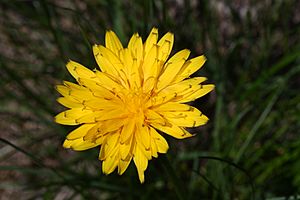Alpine lake false dandelion facts for kids
Quick facts for kids Alpine lake false dandelion |
|
|---|---|
 |
|
| Scientific classification | |
| Kingdom: | |
| (unranked): | |
| (unranked): | |
| (unranked): | |
| Order: | |
| Family: | |
| Genus: |
Nothocalais
|
| Species: |
N. alpestris
|
| Binomial name | |
| Nothocalais alpestris (A.Gray) K.L. Chambers
|
|
| Synonyms | |
|
|
Nothocalais alpestris is a type of flowering plant. It belongs to the aster family, which includes daisies and sunflowers. People often call it the alpine lake false dandelion.
This plant grows naturally in the Cascade Range and Sierra Nevada mountains. You can find it in other mountains from northern Washington to central California. It prefers subalpine areas, which are high-altitude forests and meadows. It usually grows between 1,200–2,700 m (4,000–9,000 ft) above sea level.
About the Plant
Nothocalais alpestris is a plant that lives for many years. It grows from a thick, root-like base called a caudex. The plant is mostly smooth, with very few hairs. It can grow up to about 25 cm (10 in) tall.
The leaves of this plant grow around the bottom of its stem. They can be up to 20 cm (8 in) long. Their edges can be toothed, wavy, or smooth. Sometimes, they have a thin layer of tiny hairs.
The plant produces a single flower head. This flower head usually grows on a stem without leaves. The green parts that protect the flower bud are called phyllaries. They are smooth and often have small purple dots. These phyllaries are almost the same length, but the outer ones are wider.
The flower head has many yellow ray florets. These are the petal-like parts you see. It does not have any disc florets, which are usually found in the center of some daisy-like flowers.
After the flower blooms, each floret produces a fruit. This fruit is a small, tube-shaped seed called an achene. It can be up to 1 cm (1⁄2 in) long. Each achene also has a large, fluffy top called a pappus. This pappus is made of up to 50 white, hair-like bristles. It can add another centimeter to the length of the fruit. The pappus helps the seeds float away in the wind.
See also
 In Spanish: Nothocalais alpestris para niños
In Spanish: Nothocalais alpestris para niños


